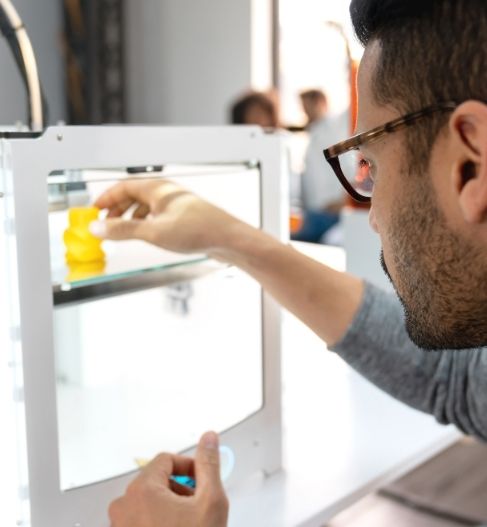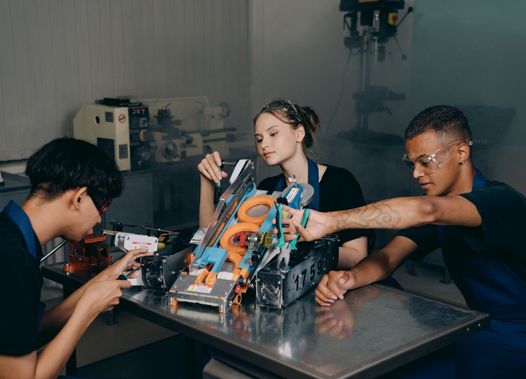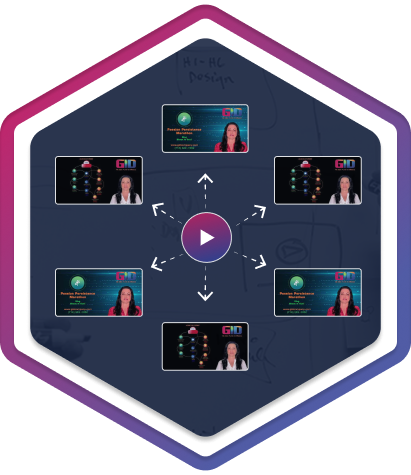Mechanical Design Services - GID Company
Leading Mechanical Design Company in California, USA
Process of Mechanical Designing
Collaborative Development:
We partner closely with you to understand your product development needs, target market, and project goals. This collaborative approach ensures your product aligns perfectly with your vision and market demands.
Design & Engineering Expertise:
Our team of skilled designers and engineers combine their expertise to create functional, user-friendly, and aesthetically pleasing mechanical products. We leverage cutting-edge design tools and engineering principles to optimize performance and manufacturability.
Market & Cost Optimization:
We don’t just design exceptional products; we create them for success. We consider market trends, user preferences, and cost-effectiveness throughout the process, ensuring your product is desirable and commercially viable.
Streamlined Manufacturing:
We have established relationships with reliable manufacturers, allowing for a smooth transition from design to production. We can assist you in selecting the most suitable manufacturing processes and materials to bring your product to life efficiently and cost-effectively.

Mechanical Design Services - What's included?
Leading Mechanical Design Firm in California, USA

- Concept Development & Refinement: We collaborate closely with you to explore and refine your initial product concept. This involves brainstorming, sketching, and ideation sessions to solidify the core features and functionality of your mechanical product.
- 3D Modeling & Prototyping: Our skilled designers utilize advanced 3D modeling software to create detailed virtual representations of your product. We then bring your design to life through rapid prototyping techniques, allowing for early validation and testing.
- Engineering Analysis & Optimization: Our experienced engineers perform rigorous analyses to ensure the structural integrity, performance, and reliability of your mechanical product. We optimize the design for manufacturability, cost-effectiveness, and ease of assembly.
- Complete Documentation & Manufacturing Liaison: We provide all technical documentation and support throughout manufacturing for seamless production.

Let's Bring Your Product Vision To Life
Don't let your vision remain just an idea. Contact us today and let's start building the future of your product.
The Impact of Mechanical Design Services
Mechanical Design Company Near You
Investing in Professional Mechanical Design Services is not just an expense; it's a strategic investment that yields substantial returns for your product and business. A well-executed mechanical product design can be the difference between a product that merely functions and one that thrives in the market. Here's how mechanical product design services can elevate your product:
Enhanced Product Performance
Expert design ensures optimal performance under various conditions. Engineering analysis minimizes failure risks, leading to a reliable product.
Improved User Experience
Our product design considers ergonomics and user interaction, resulting in intuitive, easy-to-use products. A positive experience boosts customer loyalty.
Increased Market Appeal
A well-engineered product with visual appeal naturally attracts attention. By seamlessly combining aesthetics and functionality, we make your product stand out.
Cost-Effective Production
Early focus on manufacturability optimizes production processes, reduces waste, and streamlines assembly, saving costs during mass production.
From Idea to Reality - Watch How We Do It!

Our Mechanical Design Process
Expert Mechanical Designers in California, USA
-
Conceptualization
Collaborate to define your vision. Brainstorm innovative concepts, analyze user needs & market trends. Sketch initial designs to lay the groundwork for your mechanical product. -
Requirements Definition
Clearly outline product specifications. Determine size, weight, materials, performance goals, and any industry standards. Set the stage for a targeted design. -
Preliminary Design
Craft a basic framework. Develop initial 3D models, explore design alternatives, and evaluate their feasibility. Establish a visual representation of your concept. -
Detailed Design
Dive into specifics. Refine 3D models with intricate details, select materials, and define tolerances. Create precise engineering drawings to guide manufacturing. -
Analysis & Simulation
Test before you build. Utilize FEA, CFD, and other simulations to validate structural integrity, fluid dynamics, and overall performance. Ensure your design is robust. -
Prototyping
Bring your design to life. Create physical prototypes using 3D printing or CNC machining. Evaluate form, fit, function, and gather valuable user feedback. -
Testing & Validation
Put your prototype through its paces. Conduct rigorous tests to assess functionality, durability, and performance under real-world conditions. Uncover and address any flaws. -
Iterative Refinement
Perfection through iteration. Analyze test results, gather feedback, and refine your design. Repeat this cycle until your product meets all requirements and expectations. -
Final Design
Lock in the blueprint. Create detailed manufacturing drawings, finalize material choices, and prepare comprehensive documentation. Set the stage for production. -
Manufacturing & Assembly
From design to reality. Partner with trusted manufacturers to produce your product, ensuring adherence to specifications and quality standards. -
Quality Control
Never compromise on quality. Implement rigorous inspections and testing at every stage of manufacturing to ensure your product meets the highest standards. -
Deployment & Maintenance
Launch and support. Assist with product launch, provide customer support, and monitor performance. Adapt to user feedback for continuous improvement.
Why GID Company as your Mechanical Design Company?
Trusted Mechanical Designers in California, USA
When it comes to Mechanical Designing, GID Company distinguishes itself as a leader in innovation, expertise, and client-centricity. Our team of seasoned engineers and designers is not only passionate about mechanics but also deeply invested in your product's success. Here's why GID Company is the ideal partner for your mechanical product design needs:
Mechanical Engineering Mastery
Our team possesses in-depth knowledge of mechanical principles, materials, and manufacturing processes. This expertise translates into designs that are not only functional but also optimized for performance, durability, and manufacturability.
Proven Track Record
We have a history of delivering successful mechanical product designs across diverse industries. Our portfolio showcases our ability to tackle complex challenges, from intricate mechanisms to large-scale industrial equipment.
Cutting-Edge Technology
We utilize state-of-the-art design and simulation tools to ensure precision, efficiency, and accuracy in every project. Our commitment to staying ahead of the curve guarantees that your product benefits from the latest advancements in mechanical engineering.
Client-Focused Collaboration
We believe in building strong partnerships with our clients. Your input and feedback are valued at every stage of the design process, ensuring the final product aligns perfectly with your vision and business goals.
Not Sure Where To Start?
Call JIM
Frequently Asked Questions - FAQs
-
What are mechanical engineering design services?
Mechanical engineering design services involve the creation, analysis, and refinement of mechanical systems or products. These services typically include concept development, 3D modeling, prototyping, testing, and optimization to ensure functionality, efficiency, and safety. At GID Company, our Mechanical Design services provide comprehensive solutions from initial concept to final product, ensuring that every design meets the specific needs of your project, whether for consumer products or complex industrial systems.
-
What does a mechanical designer do?
A mechanical designer works on designing, drafting, and developing mechanical components, systems, or products. Their role includes creating detailed 3D models, generating engineering drawings, and ensuring that the design is functional, manufacturable, and meets all specifications. At GID Company, our mechanical designers collaborate closely with engineers and clients to deliver innovative and precise mechanical designs that drive the success of your product development process.
-
How much does a mechanical engineer design cost?
The cost of mechanical engineering design varies depending on the complexity of the project, the level of detail required, and the scope of services. Typically, the cost can range from a few thousand dollars for smaller projects to tens of thousands for large, intricate designs. GID Company offers competitive pricing for our Mechanical Design services, with a focus on delivering high-quality, cost-effective solutions tailored to your specific project needs.
-
What types of mechanical products does GID Company specialize in designing?
GID Company has experience designing a wide range of mechanical products, including consumer electronics, industrial machinery, automotive components, and more. Our expertise spans various industries, allowing us to tailor our approach to your specific product needs.
-
How does GID Company ensure the manufacturability of mechanical product designs?
We prioritize Design for Manufacturing (DFM) principles throughout the design process. This involves considering factors like material selection, production techniques, and assembly methods to ensure your product can be produced efficiently and cost-effectively.
-
What are the three types of mechanical design?
The three main types of mechanical design are:
- Conceptual Design: Developing an initial idea or concept for a product or system.
- Preliminary Design: Refining the concept into detailed sketches, 3D models, and early-stage prototypes.
- Detailed Design: Finalizing all aspects of the design, including technical drawings, materials, and specifications for manufacturing.
GID Company excels in all three types of Mechanical Design, guiding clients through each stage to ensure a robust, well-optimized product.
-
Can GID Company help with prototyping and testing of mechanical product designs?
Absolutely! We offer comprehensive prototyping and testing services to validate your design before moving to production. We can create functional prototypes, conduct various tests to assess performance, and refine the design based on the results.
-
What is the typical timeline for a mechanical product design project with GID Company?
The timeline for a mechanical product design project varies depending on the complexity and scope of the project. However, we work closely with our clients to establish realistic timelines and milestones, ensuring timely delivery without compromising on quality.
-
How does GID Company protect my intellectual property during the mechanical product design process?
We understand the importance of safeguarding your intellectual property. We have strict confidentiality agreements in place to protect your ideas and designs throughout the project. You can trust us to handle your confidential information with the utmost care and discretion.
-
What does mechanical design deal with?
Mechanical design deals with the creation and development of mechanical components, devices, and systems. It involves the application of engineering principles to design products that perform specific functions, ensuring they are reliable, efficient, and manufacturable. GID Company’s Mechanical Design services cover a wide range of industries, delivering high-precision designs that meet both functional and aesthetic requirements while adhering to industry standards.















